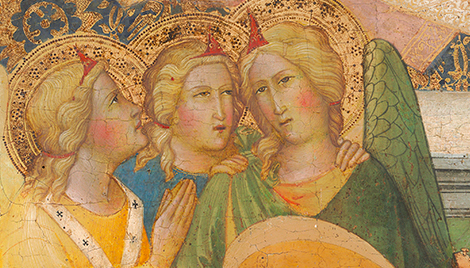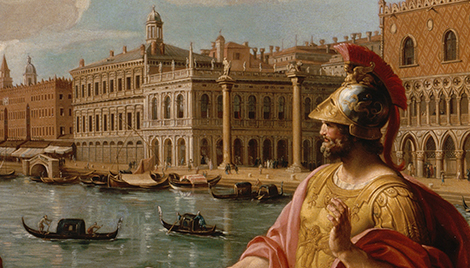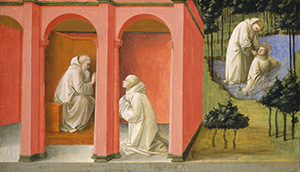Saint Benedict Orders Saint Maurus to the Rescue of Saint Placidus
Saint Benedict Orders Saint Maurus to the Rescue of Saint Placidus
- Artist
- Fra Filippo Lippi
- Artist Dates
- c. 1406-1469
- Artist Nationality
- Italian
- Title
- Saint Benedict Orders Saint Maurus to the Rescue of Saint Placidus
- Date
- c. 1445/1450
- Medium
- tempera on panel
- Dimensions
- 40 x 69.5 cm (15 3/4 x 27 3/8 in)
- K Number
- K1342
- Repository
- National Gallery of Art
- Accession Number
- 1952.5.10
- Notes
Provenance
Part of a predella, possibly that of the main altarpiece of the church of San Bernardo in Arezzo, which was subsequently removed from the altar and dismembered, but remained in the adjacent monastery of the Olivetans until at least 1767. [1] probably Michele Cavaleri, Milan, by the mid-nineteenth century or later; [2] acquired 1873 by Enrico (Henri) Cernuschi [1821-1896], Paris and Menton. [3] Édouard Aynard [1837-1913], Lyons, by 1900; [4] (his sale, Galerie Georges Petit, Paris, 1-4 December 1913, 1st day, no. 52); Hoentschel. [5] Mme Douine, Château de la Boissière, Seine-et-Oise; (Wildenstein & Co., Inc., New York); sold December 1942 to the Samuel H. Kress Foundation, New York; [6] gift 1952 to NGA. [1] In an important essay, Jeffrey Ruda ("Style and Patronage in the 1440s: Two Altarpieces of the Coronation of the Virgin by Filippo Lippi," _MittKIF_ 28 [1984]: 384) succeeded in identifying the altar panel, then still in its original frame and considered a single piece, in a 1767 inventory of the monastery of San Bernardo (Archivio di Stato, Florence, Compagnie Religiose Soppresse in Arezzo, B. XLVIII, no. 10, f. 190r.). In 1782 the Olivetans were transferred to the monastery of Santa Maria in Grado, also in Arezzo, and three years later their new house was suppressed and its belongings dispersed. The _Coronation_ probably remained in the city in private hands, perhaps until 1842 when it was purchased by Pope Gregory XVI from the Aretine merchant Carlo Baldesci (see Jeffrey Ruda, _Fra Filippo Lippi. Life and Work with a Complete Catalogue_, London, 1993: 418). Robert Oertel, _Fra Filippo Lippi_, Vienna, 1942: 67, and other scholars linked the execution of the altar panel to the death of Gregorio Marsuppin (represented knealing on the other side), who commissioned the painting. Gregorio, a famous jurist, died in 1444; this date can be considered a probable _terminus post quem_ for the commission. [2] That the painting came from the Cavaleri collection is only a hypothesis. Apparently no complete list has ever been published of the paintings in that collection. A. Mazzoleni (_Il Museo Cavaleri_, Milan, 1870) and Giuseppe Ferrari (_Il Museo Cavaleri_, Milan, 1871) limit themselves to citing just some of the works, for the most part Lombard, and referring to the presence of Tuscan paintings. A Milanese lawyer, Michele Cavaleri began collecting around 1845 and from 1870 on opened to the public what by then had come to be called the Cavaleri Museum. The owner hoped that the collection would be purchased by the city of Milan, but when negotiations fell through, he sold the entire collection to Enrico Cernuschi on 13 April 1873 (see Alessandra Mottola Molfino, "Collezionismo e mercato artistico a Milano," _Zenale e Leonardo. Tradizione e rinnovamento della pittura lombarda_, Milan, 1982: 247-248). [3] On the provenance from the Cernuschi collection see Fern Rusk Shapley, _Catalogue of the Italian Paintings_, 2 vols., Washington, D.C., 1979: 1:264, and the Getty Provenance Index. As Cernuschi otherwise collected mainly objects of Asian art (see Caroline Gyss-Vermande, "Cernuschi, Henri," in _Dictionary of Art_, 1996: 6:345), one may surmise that he obtained his early Italian paintings from the Cavaleri collection; see note 2. Lippi's panel is not listed in the sale catalogue for the collection (_Catalogue des tableaux anciens des écoles primitives..._, Galerie Georges Petit, Paris, 25-26 May 1900). It seems likely that the painting was sold privately sometime earlier, probaby after the collector's death in 1896. [4] On this collection, see Jean-François Garmier, "Le Goût du moyen-âge chez les collectionneurs lyonnais du XIXe siècle," _RArt_ 47 (1980): 59, 64 n. 153. [5] According to annotated copies of the Aynard sale catalogue and a newspaper account of the sale (copies in NGA curatorial files), in one of which the name is also spelled Hoentchell. A letter of 17 April 1979 from Jean-François Garmier spells the name Hohentchell (in NGA curatorial files). It is possible the buyer was Georges Hoentschel (1855-1915), a collector in Paris, who made other purchases at the Aynard sale. [6] The sales agreement for eleven paintings, including "Scenes from the Life of St. Benoit" by Fra Filippo Lippi, between Wildenstein & Co. and the Kress Foundation is dated 31 December 1942 (copy in NGA curatorial files).






